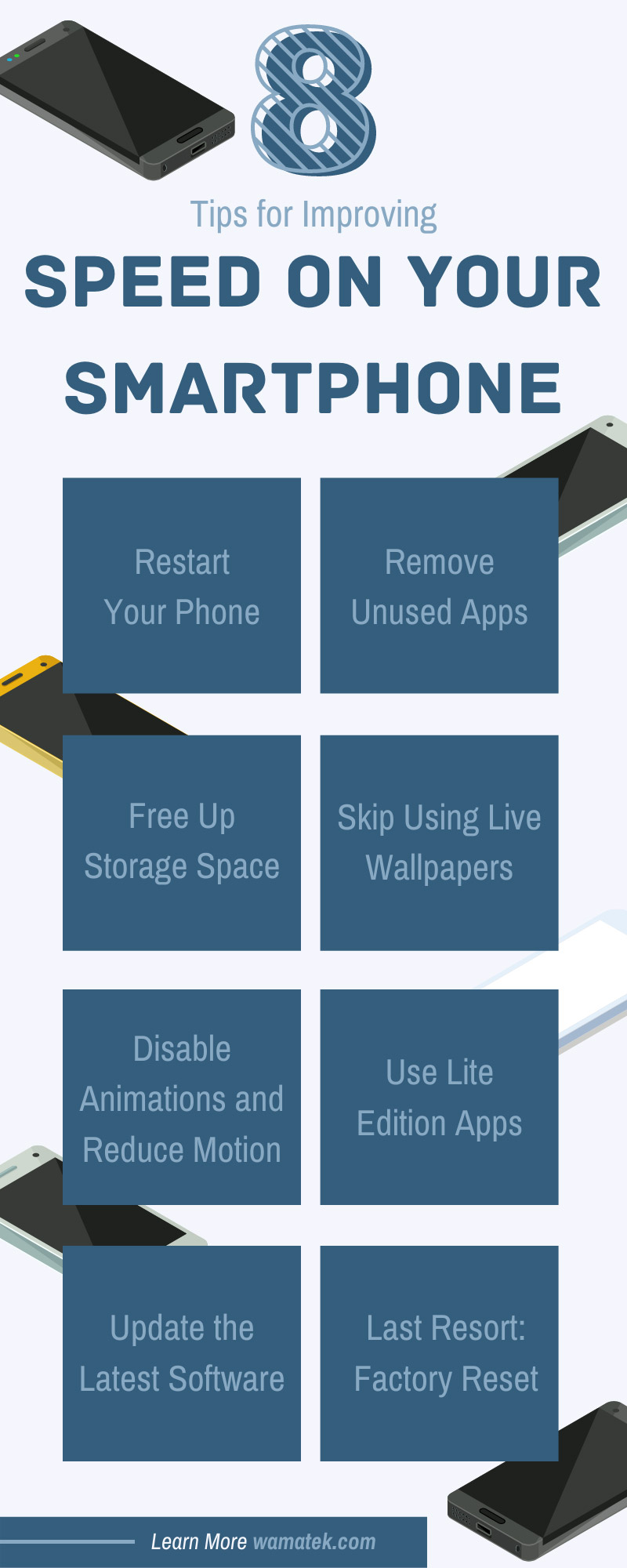Your smartphone can slow down for various reasons; the model might be old, the software could be out-of-date, your storage might be full, etc. When your phone is slow, it hinders your regular day-to-day routine and causes frustration. Using our tips for improving speed on your smartphone will increase the quality of the device and help revive it back to a similar speed as when you originally bought the phone.
Restart Your Phone
The most tried and true classic way to increase your smartphone speed is by turning your phone off and back on. Similar to how we need to rest at the end of the day, computers and other smart devices need to reboot themselves at least once a week to keep the system from bogging down your speed. On an important note, this will not give you dramatic results and might not help at all, but it never hurts to try this first before going to extreme measures.
When you restart your phone, don’t power it back on immediately after turning it off. Wait at least a minute before powering it back on. This gives the phone time to shut down and reboot fully.
Remove Unused Apps
Without you realizing, your phone might be cluttered with unused apps. Every single app you’ve used in the past is probably running in the background on your phone, slowing down the system. If you aren’t using the apps anymore or never plan to use them again, simply remove them from the device.
Too many apps take up tons of space in your storage and may be unnecessary to have. Some phone manufacturers have an automatic option to remove apps from your home screen that you haven’t used in a while. This isn’t for every carrier and device, so it is better to go through your apps every once in a while and delete unwanted ones.
Free Up Storage Space
In a way, deleting apps is freeing up storage space, but a lot more goes into a phone’s storage than you may realize. In fact, every task you perform on your phone leaves a trace that builds up in your cache or storage. The traces are left because the app can open much faster with a previous trace, but this slows down the phone tremendously.
Most manufacturers have a way to quickly optimize the storage for you built right into the phone. Go through other things in your phone that could be taking up space like photos, text messages, and music. Otherwise, you can clear your cache on your phone, deleting all the previous traces the phone made after opening apps.
Skip Using Live Wallpapers
Live wallpaper is an excellent feature to have on your phone, but it could actually be doing your phone more harm than good. The wallpaper requires several CPU cycles to run, making your phone work harder to keep its speed. This may not be the most significant factor in slowing down your phone, but sticking to static images for wallpapers and backgrounds will make your phone run faster than if you had those live wallpapers enabled.
Disable Animations and Reduce Motion
A phone has animations to help users navigate through an app and look very eye-appealing. However, these animations require a lot of resources to make them look fluid. After a while, the animations can cause lag or jittery displays. Turning them off could make the device work faster—or at least give you the illusion that everything is faster because you don’t have to wait for animations to complete. It also saves on processing power.
Removing the animations may not natively speed up your phone, but it will give you the perception that the device is working faster than it was before. This may be the trick you need to make your phone run faster—unless you notice that it is still slow.
Use Lite Edition Apps
Not everyone will have the next new and improved smartphone; if you have an older phone or a lower-end phone, apps made for faster software will slow down your phone. App developers create a “lite” version of their apps so they can work better on lower-end and older phones. Because the app storage space is smaller, it will use fewer resources and perform a bit faster.
Update the Latest Software
Occasionally, a manufacturer may release new software versions that fix problems many users of that phone face. If your phone is running on a later version of the software, chances are your phone is also running slow. Particular apps also need to be compatible with the version of software you are using, so larger apps cannot run properly if you fail to update your phone when a new patch is released.
Carriers often take feedback from their customers and use that for their software updates. Once you update your phone, it should be running a bit quicker than before.
Last Resort: Factory Reset
The last tip for improving speed on your smartphone will be your last resort—factory resetting your phone. This is a very extreme way of speeding up your phone but could be necessary to improve the performance. On a side note, factory resetting will delete your data and return the device to its factory settings, so back up any apps, songs, texts, or other personal files on your phone before resetting it.
If none of these options speed up your phone, it may be time for a new one. Wamatek sells unlocked used phones that you can buy to upgrade your old phone. Unfortunately, in some cases, the best thing you can do is to get a newer version of your phone.
Try out all these tips before resorting to a new phone. If all else fails, factory reset your phone to try to get it back to its original settings—just don’t forget to back up your phone first! Phones run slow for various reasons, but you can speed them back up a bit with these tips.




